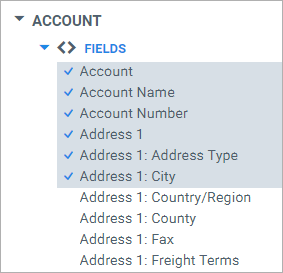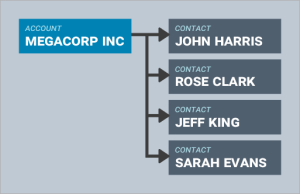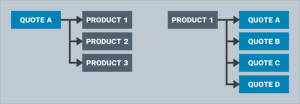Data Set structure
Entities
Data sets consist of one or more entities, each with their own fields:
We call them entities here at Experlogix, but you may find other names:
- Modules (in Sugar)
- Objects (in Salesforce)
- Entities (in Dynamics)
- Tables (in certain database types)
A data set always starts from one entity, which is called the primary entity. The primary entity defines which flows your end users can see when generating documents. In the context of flows, this entity is the primary entity of the flow.
For instance: a flow with Account as primary entity will only be available for CRM end users when they select an Account record.
Relations
You can include other entities in your data set by linking them to the primary entity via a relation. There are 3 types of relations:
- 1:N relations
- N:1 relations
- N:N relations
In a 1:N relation (one-to-many), one entity is linked to one or more instances of another entity. For instance: 1 Account with 4 Contacts that belong to that account.
An N:1 relation (many-to-one) is the same, but in the other direction. For instance: starting from Contact and linking to the Account to which it belongs.
Finally, N:N relations (many-to-many) are relations where both entities can link to multiple instances of the other entity. For instance: 1 Quote with 3 Products, and 1 Product that is used in 4 Quotes.
These relations are almost always broken down into 1:N and N:1 via an in-between entity, such as QuoteProduct. So you can select them in 2 steps: link to the in-between entity via 1:N, then to the other entity via N:1.




